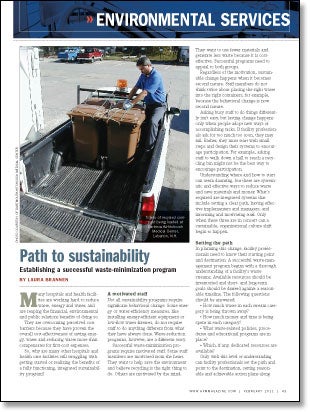Path to sustainability
 Many hospitals and health facilities are working hard to reduce waste, energy and water, and are reaping the financial, environmental and public relations benefits of doing so.
Many hospitals and health facilities are working hard to reduce waste, energy and water, and are reaping the financial, environmental and public relations benefits of doing so.
They are overcoming perceived cost barriers because they have proven the overall cost-effectiveness of saving energy, water and reducing waste more than compensates for first-cost expenses.
So, why are many other hospitals and health care facilities still struggling with getting started or realizing the benefits of a fully functioning, integrated sustainability program?
A motivated staff
Not all sustainability programs require significant behavioral change. Some energy or water-efficiency measures, like installing energy-efficient equipment or low-flow water fixtures, do not require staff to do anything different from what they have always done. Waste-reduction programs, however, are a different story.
Successful waste-minimization programs require motivated staff. Some staff members are motivated from the heart. They want to help save the environment and believe recycling is the right thing to do. Others are motivated by the mind. They want to use fewer materials and generate less waste because it is cost-effective. Successful programs need to appeal to both groups.
Regardless of the motivation, sustainable change happens when it becomes second nature. Staff members do not think twice about placing the right waste into the right containers, for example, because the behavioral change is now second nature.
Asking busy staff to do things differently isn't easy, but lasting change happens only when people adopt new ways of accomplishing tasks. If facility professionals ask for too much too soon, they may fail. Rather, they must start with small steps and design their systems to encourage participation. For example, asking staff to walk down a hall to reach a recycling bin might not be the best way to encourage participation.
Understanding where and how to start can seem daunting, but there are systematic and effective ways to reduce waste and save materials and money. What's required are integrated systems that include setting a clear path, having effective implementers and managers, and informing and motivating staff. Only when these three are in concert can a sustainable, organizational culture shift begin to happen.
Setting the path
In planning this change, facility professionals need to know their starting point and destination. A successful waste-management program begins with a thorough understanding of a facility's waste streams. Available resources should be inventoried and short- and long-term goals should be drafted against a reasonable timeline. The following questions should be answered:
- How much waste in each stream category is being thrown away?
- How much money and time is being spent in each category?
- What waste-related policies, procedures and educational programs are in place?
- Which, if any, dedicated resources are available?
Only with this level of understanding can facility professionals set the path and point to the destination, setting reasonable and achievable action plans along the way. Otherwise, they might choose a destination that is unreachable. Facility professionals could set a 50 percent recycling goal. But without understanding that they're currently recycling only 5 percent and they have no infrastructure in place to get to that number they are sure to fail. Maybe 50 percent is a visionary, long-term strategic goal, but a short-term destination goal of 20 percent might be better.
With the destination in mind, facility professionals then need to define the critical steps to motivate staff. The question is, how?
Drivers and barriers
A health care organization's leadership may be motivated to reduce waste by any number of drivers: the imperative to save money; a response to internal and external community pressures; improving regulatory compliance; and addressing climate change.
Understanding the drivers will help professionals design programs so that the outcomes will be in alignment with the drivers. For example, replacing Styrofoam in the cafeteria, which is a break-even proposition at best, may not be among the priority projects if the driver is saving money. (If the driver is responding to staff pressure to replace Styrofoam, the project makes more sense.)
Ideally, leadership flows down from the C-suite, bottom up from every department's front-line staff, and from a designated staff person in the middle with clear accountability and focused attention.
Assigning the right person with the skills and passion to do the job is a smart investment. If facility professionals want their strategy to succeed, they should not assign waste reduction and management to someone who already has a full plate.
Adding a sustainability coordinator to the organizational chart pays for itself. This person can be the change agent when combined with an informed team and a motivated organization. Better resource management and waste-reduction opportunities abound, but it takes a leader to set the path, define the action plans and motivate that action.
Support staff members are the backbone of a waste-management program. They should be asked what they are seeing on the patient floors, in administrative areas, in the pharmacy and laboratories. They should be used to inform the strategy, educate others and rally change. When facility professionals build the team and set the path, they must reach out to support staff to take advantage of their knowledge and suggestions.
Motivating and informing staff
Well-intentioned and even well-organized programs will fail if staff are not informed. For waste management, for example, there are many choices to make about which recycling waste goes where. Understanding why it's important that staff make the right choices provides the motivation to do it right.
From the first day on the job and once a year thereafter, staff members should have access to a waste dashboard that provides such performance improvement data as: increases in the recycling rate; decreases in the regulated medical waste-generation rate; money saved; whether current goals have been met; and progress toward future goals.
Coordinated training and educational materials can be targeted to three levels. The first is tactical; for instance, all containers should be properly color-coded and clearly labeled. The second is educational; for example, waste handling guidelines should be posted in utility rooms and break areas. Finally, motivational or visionary posters speak to the mission and commitment of the organization. All three should communicate the change staff members are being asked to make, and the difference it is making toward the organization's environmental and financial goals.
Setting the path also means defining goals and action plans. Three goals might include launching an expanded recycling program, starting a donation and reuse program, and reducing a single-source of waste such as paper.
Assess the current recycling program and then set a reasonable goal. For example, a facility might have blue recycling bins left over from a failed recycling program being used as regular trash receptacles throughout the facility. This requires changing up the situation; simply sending out an e-mail announcing the program and asking staff to use the current blue bins may not be enough to rally change.
To be successful, health facility professionals would need to start a movement — a "take back the blue bin" campaign. This could include relabeling them and moving them around, monitoring how they are used, and communicating how the program is doing via newsletters, e-mail and even patient menus.
It is also important for facility professionals to understand their current disposal practices for furniture, equipment and supplies. Most of these materials can be reused in-house or donated to local or international charities. For in-house reallocation of materials like furniture and office supplies, facilities can create an internal eBay-like program for a relatively small investment of time and money. This allows staff to swap furniture and other materials, drastically reducing the amount of waste the health care facility sends to the landfill, and filling a need for departments looking for furniture or supplies. For other usable materials that cannot be reallocated in-house, facility professionals can create a list of local organizations to which they can donate.
Additionally, there are many opportunities for source reduction, which means reducing the amount and kinds of materials that are purchased and used just once in many cases. Paper reduction is a great example. An easy way for facility professionals to use less paper is to ask IT departments and copier contractors to set printer and copier defaults for double-sided copies.
Then, survey every department that prints and distributes reports (e.g., admitting, lab, medical records) to ensure they are being utilized effectively, and discontinue distributing them if they are not. Making reports available online can help, but there are still many paper reports being generated, perhaps unnecessarily.
Whatever the goal and action plan, facility professionals should articulate the mission clearly, create movement by providing the right motivational education material, and inspire action by communicating the change.
A main pillar
Waste management is one of the main pillars of a health care facility's sustainability program, and for good reasons. It communicates a public commitment, it makes a difference for the environment and it saves money. The most forward-thinking facilities have expanded their waste minimization and recycling programs to reducing waste before it's created, right at the source.
Regardless of where a facility is on this spectrum, developing and implementing an effective waste-management plan can help facility professionals start to capitalize on dozens of opportunities that exist today for waste and cost reductions - and move toward greater efficiency and a reduced impact on the planet. HFM
Laura Brannen is senior environmental performance consultant for Mazzetti Nash Lipsey Burch (M+NLB), a mechanical, electrical, plumbing, technology engineering and environmental performance consulting and design firm headquartered in San Francisco. She can be reached at lbrannen@mazzetti.com.
| Sidebar - Assessing the waste stream |
| The best place to start a detailed waste-stream assessment is by creating a list of all materials that are leaving the facility — even reusable or donated materials. One such list can be found on the Sustainability Roadmap website at www.sustainabilityroadmap.org, which was launched by the American Hospital Association's American Society for Healthcare Engineering, Association for the Healthcare Environment and the Association for Healthcare Resource & Materials Management. For each item on the list, collect the following information:
Waste management is complex not only because there is so much of it, but also because it tends to be decentralized in most health care facilities. Moreover, because there are big differences in the implications of managing highly regulated, hazardous chemical and medical wastes and recyclable waste, recyclable waste may get short shrift. Without a coordinated effort among all health facility staff, opportunities easily can be overlooked. Spending the time and resources to do the trip planning right, however, will provide the critical information needed to plan the journey adequately and define the destination. |
| Sidebar - Selling it to the C-suite |
| Dr. Gus Kious, president of Huron Hospital, a Cleveland Clinic hospital in East Cleveland, Ohio, presented a bold goal to his staff: Reduce waste by 50 percent. Kious was motivated by the amount and types of waste he saw in the hospital's trash cans and he knew his organization could do better. Today, Huron is a leader with a growing waste-reduction rate of about 40 percent. The positive results have overflowed into the hospital's improving other systems, processes and outcomes in hospital length of stay, supply costs, quality core measures and many other operational, financial and sustainability goals. The success of a sustainability program may not hinge on the CEO's personal commitment, but there are ways to make the business case to C-level executives and the board of trustees about the benefits of better waste management — from potential cost savings by purchasing less wasteful material, to more cost-effective disposal and environmental benefits from landfill and incineration diversion, to climate change and energy-saving improvements. A vibrant recycling and waste minimization program is an opportunity to let staff, patients and the local community know about the facility's commitments. Exemplifying hospital leaders' commitment to reduce waste is a great opportunity for staff members to identify with their organization. It can even be a recruiting tool. Many hospitals have issued "sustainability statements" that declare the organizational commitments and objectives to environmental and related community health values. Some are even endorsed by the organization's trustees. If a hospital has such a statement, linking the waste management goals to this document may be key to persuading management to support the effort. If the organization doesn't have a sustainability statement, samples can be found on the Sustainability Roadmap website at www.sustainabilityroadmap.org, which was launched by the American Hospital Association's American Society for Healthcare Engineering, Association for the Healthcare Environment and the Association for Healthcare Resource & Materials Management. |




